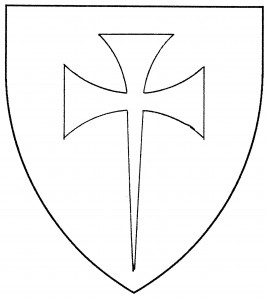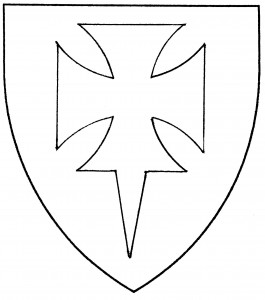A cross “fitchy” is any cross whose lower limb has been replaced with a long point. The term derives from the French for “fixed (in the ground)”; the cross is stuck into the ground by its point. Such crosses fitchy date from the earliest heraldry, as in the arms of de Vesci, c.1244 [Asp2 215]. Some modern texts use the term synonymously with “pointed”, and talk of a “cross fitchy at all limbs”; but this is a misunderstanding of the term, and should not be used. Normally the upper limbs of a cross fitchy are also treated, in some other way (since they cannot readily be throughout); the bottom limb is typically somewhat longer than the other three, and comes to a tapering point. The illustration shows a cross formy fitchy.
A cross “fitchy at the foot” (or “fitched at the foot”) is an artistic variant of the cross fitchy, where the point does not replace the lower limb, but instead issues from its center. In period, the usage seems only to have been used with crosses with splayed limbs: e.g., the cross formy fitchy at the foot, as seen in the banner of the Kings of Aragon, c.1370 [Gelre 62v] (and in the illustration), or the cross potent fitchy at the foot, c.1340 [Zurich 18].
Launcelot de Westwood bears: Azure, a cross botonny fitchy Or.
Cathleen de Barre bears: Gules, three crosses crosslet fitchy Or.
Seth Williamson of Exeter bears: Lozengy purpure and Or, a cross formy fitchy argent.
Olafr the mercenary bears: Per pale argent and gules, two crosses formy fitchy at the foot counterchanged sable and Or.

